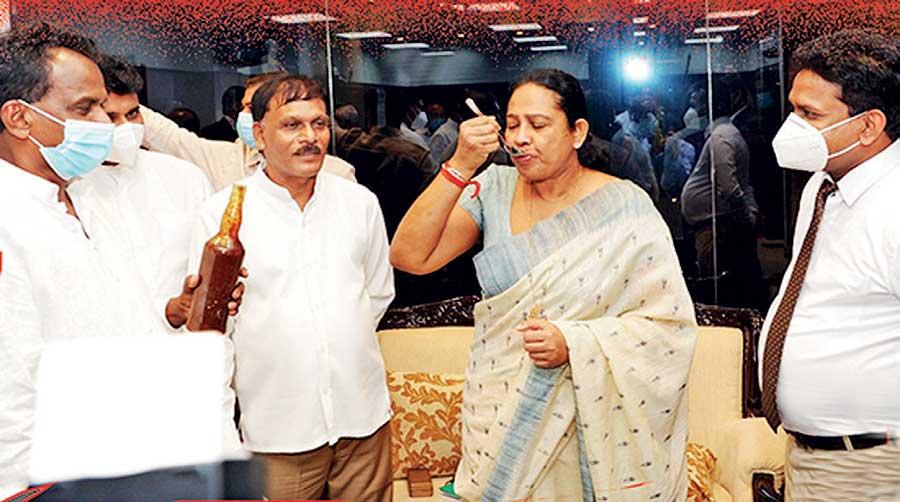28 Dec 2020 - {{hitsCtrl.values.hits}}
Is Ravana Decoction Traditional?

A ferocious inferno is flaming the nation; Dhammika Bandara’s Kali Peniya offered to Dalada Maligava and Sri  Maha Bodhi, has received registration from Ayurvedic Department. Before the ink on the registration document dried, another preparation supposedly an ancient concoction formulated by mythical multi-headed Ravana and allegedly inscribed in a Ranpatha [Gold sheaves] which was unearthed in Ridigama has appeared.
Maha Bodhi, has received registration from Ayurvedic Department. Before the ink on the registration document dried, another preparation supposedly an ancient concoction formulated by mythical multi-headed Ravana and allegedly inscribed in a Ranpatha [Gold sheaves] which was unearthed in Ridigama has appeared.
A plant-derived preparation as prescribed, this Arishtaya is now doing the rounds. Will it be tasted by the Health Minister before Minister of Industries donates required machinery out of taxpayers’ money for the Ravana devotee to commence his procession to Kandy and Anuradhapura? Will they announce free distribution for electronic media to go to town inviting another massive gathering and a new Ravana cluster creating a third wave for the virus?
Value of Traditional Systems of Medicine
The traditional medicine systems should be safeguarded from both the mythical magicians and Politicos of both sides of the divide for these systems has been practised here for over 3,000 years. Evidence of the existence of hospitals during Monarchies by Pandukabhaya [437-367 BC], Dutugemunu [161-137 BC] and Buddhadasa [341-370 AD] and medicinal boats found in archaeological sites of ancient cities, stand testimony in favour of the above claim.
"Ravana has been Ritualized of as Healer In the current glorification of Ravana, the enthusiasts construct material expressions such as shrines, statues, and rituals are being practised with an increased feeling of majoritarianism, making him a legendary national conqueror of the Sinhalese-Buddhist fostered by mind-set of triumphalism in the aftermath of the civil war."
Focussing on the anti-cancer potential of natural Sri Lankan plants, a research paper submitted by a team of three Science Faculty academics selected from three universities have found several plant species that possess Cytotoxic activity.
It summarizes current information regarding our plant material that acquire anti-cancer properties. Being home to around 3,700 plant species, half of which are medicinal plants and with a good percentage of the population for centuries, relying on traditional medicines for treating a variety of deceases including tumours, the paper concludes, these medicinal plant sources should be used to overcome
terminal illnesses and for prevention of deceases.
Maha Ravana Nanumura Ceremony
The prevailing discussion on Ravana has been extensive in the recent past especially in a few TV and FM channels backed by some ‘Sinhala-Buddhist-nationalists sects.
They are on the verge of being redefining the Sinhala nation challenging the origin of the Sinhalese, earlier believed to be descendants of the Aryan Prince Vijaya, who reached the island two and a half millennia ago.
This new tale identifies king Ravana as the inventor of the Sinhala nation. Why this rush of curiosity in Ravana? Ravana is talked about in Ramayana in detail and other classics of India.
The contents of a book believed to be written on gold and copper plates were subsequently copied onto ola leaves and the original gold and copper folios had been bestowed by Adigar Wickramasinghe Chief Adigar of King Jayaweera I (1514- 42) to Mahiyangana temple.
As revealed by Cabinet Spokesman Dr Ramesh Pathirana, the Ayurveda Department has, in an unexpected move, permitted the clinically untested Dhammika syrup, which is being paraded as a therapy for the virus.
Opinions differ only on political interests. The issue has been politicised like every other major concern.
Some ministers are promoting it uncompromisingly, while the opposition is scoffing at the controversial decoction and its creator.
Ravana has been Ritualized of as Healer In the current glorification of Ravana, the enthusiasts construct material expressions such as shrines, statues, and rituals are being practised with an increased feeling of majoritarianism, making him a legendary national conqueror of the Sinhalese-Buddhist fostered by mind-set of triumphalism in the aftermath of the civil war.
"As revealed by Cabinet Spokesman Dr Ramesh Pathirana, the Ayurveda Department has, in an unexpected move, permitted the clinically untested Dhammika syrup, which is being paraded as a therapy for the virus. "
This dangerous glorification of an ancient indigenous society in the island of Sri Lanka is being used as a way to convey feelings of superiority over minorities. The recently invented ceremonies performed for Ravana at a famous Buddhist temple in Pannipitiya and efforts embarked on the Ravana discourse have helped create an illustration of a so-called splendid past.
Both the customs and the communication are thus motivating the adherents to rouse a sense of the imagined heritage of the nation and a delight of being Sinhalese.
They play a major role in the ritualizing of the concept that Ravana was a healer. After the ritual Nanumura Mangalyaya, a custodian brings out one huge bowl which contains red coloured concoction for the people who waited in the queue for hours to apply the stuff to their heads believing that it possesses curative powers and protect them from diseases.
The committee appointed to study the Dhammika Peniya will get an extension to waste time taking up Ravana decoction as well; and there will be many more, with hundreds of syrups and Arishtas invented by interested parties are in the pipeline expecting similar publicity and recognition.
Opposition leader’s Pansakuula Rhetoric and Ranawaka moves
The problem of Covid burials remains unresolved for Opposition Samagi Jana Balavegaya (SJB) to make street dramas. Champika Ranawaka’s main objective, as revealed by him at last Parliamentary election campaign was, ‘to relieve the voter of this country of family dynasties’ and he appealed to the voters to make him the no.1 in the Colombo District from the Samagi Jana Balavegaya, where his leader Premadasa contested too.
A practical, energetic Opposition can challenge the popular and powerful Government. Sajith and his team so far have proved ineffective compared to past oppositions. The SJB leader needs good advisers.
Sajith who in Parliament accused the Government of violating the rights of Muslims by cremating the dead a few days ago, faultily surmised that he would lose the Sinhala-Buddhist base by demonstrating in front of Kanatte in support of Islam.
Hence he spoke for Buddhists as well creating an unprovoked situation as Buddhists or Christians have never demanded the bodies to perform religious rituals.
Last Thursday we saw photos of Muslim clergy and lay carrying the body of Buddhist monk in Trinco for cremation sans politicians. Sajith should not use the issue to gain political mileage. If he does that it would incite communal friction and he will lose credibility.
Ranawaka resigned from the post of General-Secretary of the JHU and the membership of the party.
He said “the leftovers of traditional political families are still running the country, the necessity is a strong political pressure group at the grassroots level. We need a superior dynamic group to move forward. We need a colossal collective movement. The clergy and the youth have an enormous duty to participate in this.”
He is committed to building that public structure in the future. The family dynasties, Champika spoke of—only two remain in today’s politics; they are Rajapaksas and Premadasas. Sajith has a lot to learn, especially the art of changing strategies.
We need a prudent opposition not a high-pitched group of
tireless raconteurs.
The writer can be contacted at – [email protected]
30 Nov 2024 2 hours ago
30 Nov 2024 4 hours ago
30 Nov 2024 5 hours ago
29 Nov 2024 29 Nov 2024
29 Nov 2024 29 Nov 2024